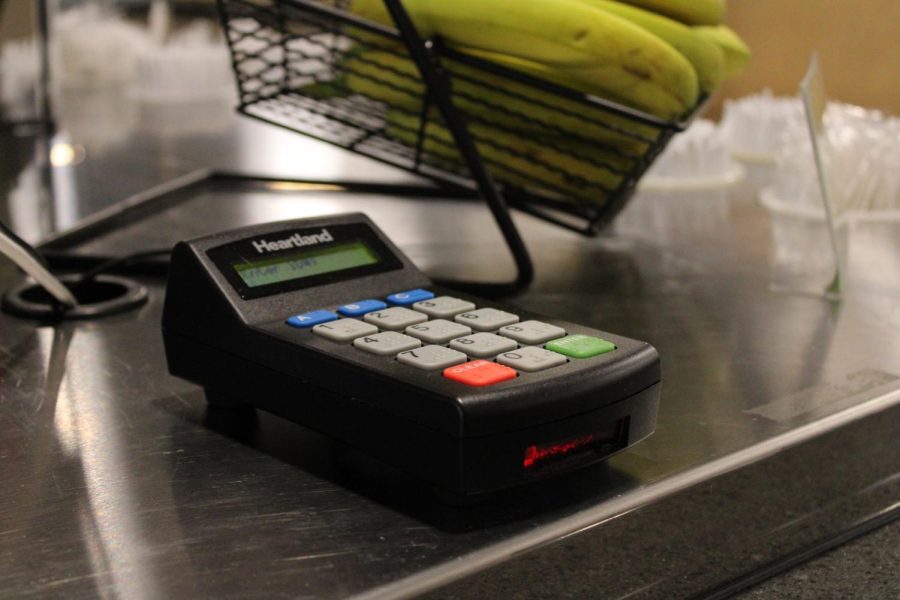In Defense of Free Meals
At State High, students pay for snacks or extra meals by entering their student PIN number into keypads like the one pictured. During lunch and breakfast times this year, this step to the process of getting food was eliminated due to free meals.
April 22, 2022
Free meals in public schools reduce childhood and food insecurity. Since the beginning of the pandemic in 2020, SCASD has taken on a new approach to school meals that hasn’t been used before. Meals, both breakfast and lunch, have been provided for free to all students at school, regardless of their financial situation. However, the program, which is intended to lessen the burden of the pandemic on families, is a temporary one. At the start of the 2022-2023 school year, it will no longer be in place, and students will be expected to buy school lunch and breakfast with the money in their accounts instead.
The Universal Free Meals waivers issued by the USDA at the beginning of the pandemic helped schools to feed an additional 10 million more children across America. If this waiver isn’t extended, approximately 30 million children will then not be able to eat school lunch due their financial strains. These crucial waivers expire this June 30th. Annually, the cost of the Universal Free Meals program is $11 billion dollars. Although extending the waivers is financially a significant ask, it is also necessary. Many government officials are surprised and infuriated at this outcome, and are supporting a new bill “Support Kids not Red Tape” act; a bill that would extend the waivers for the upcoming school year.
The general argument for no longer offering free meals to all students is that students who do need free lunch can receive it, and those who don’t can pay. Although on paper this seems logical, in practice, this plan is not necessarily effective. How poverty is measured, which ties into the requirements one must meet to qualify for reduced-price meals, makes a great deal of difference.
According to the PA Department of Education, children from families with incomes at or below 130% of the poverty level, children in families receiving Temporary Assistance for Needy Families (TANF) and children in families receiving food stamp benefits are eligible for free lunches. For the SCASD meal program, families with gross income of less than $4,086 per month are eligible for meal benefits. These requirements do not take into account a multitude of factors that contribute to financial insecurity.
First and foremost, being above the poverty line is not an accurate measure of being financially secure. The same is true for having an income of more than $4,086 per month. How much money is coming into a household is only a small portion of the big picture. Everyone’s situation is different, and while some may only need to provide for themselves, others have relatives, friends, or neighbors they may also be responsible for. Some households may be paying high medical bills, while others must section off hefty amounts for their businesses or education. So, although two families may have the same income on paper, they are likely to have different financial burdens, and therefore different amounts of money to spend on food. People who don’t meet the qualifications of the government or school could still greatly benefit from the burden of purchasing meals being eliminated.
Having access to full, nutritional meals during the school day inhibits learning in both the behavioral and academic realms. Cells in the brain rely on energy from food so that they can function properly. When the brain doesn’t receive enough food, neural function and brain chemistry is negatively impacted. This can cause many issues, some being the inability to concentrate and memory loss. For that reason, hungry students aren’t as able to concentrate during class and absorb information the same way that nourished, fed students are able to. Therefore, this puts many students at an unfair disadvantage educationally.
Having Universal Free Meals enables our school to prepare healthier options for lunch. When families and kids are paying for meals, they are customers to State High’s food services. In that case, the food services have to adapt to a business mindset because they need kids to buy lunch. With Universal Free Meals, the chance of kids trying new, more nutritious foods rises because it’s not a direct expense to them. Megan Schaper, the director of SCASD Food Services, expanded on the benefits of Universal Free Meals.
“Universal Free Meals would give school food services and operations more freedom to push the limits on getting healthier foods to continue.” Schaper said. “I do think school meals are healthy, but I do also think that we have to meet a lot of different criteria. One is making sure kids want to come and get lunch in the cafeteria, so free meals would make that a little bit easier.”
Physical health is directly entwined with mental and emotional health; when one suffers, the other tends to follow suit. It has been shown through both data and experience that when kids are not well fed, their emotions are negatively affected. Sadness, anger, and lack of motivation become more intense and harder to handle. This can lead to behavior problems both in and outside school, as kids will tend to act more erratically and aggressively. A healthy school environment requires healthy, well-adjusted people, both emotionally and physically.
According to the Food Research & Action Center, children experiencing hunger are more likely to be hyperactive, absent, and tardy, in addition to having behavioral and attention problems more often than other children. Teens experiencing hunger are also more likely to have been suspended from school and have difficulty getting along with other children.
Just as physical issues such as hunger and malnutrition lead to behavior problems, behavior problems lead to academic difficulties. Anyone can attest to the fact that it’s much more difficult to focus and perform when the body is not well fed and rested. Therefore, beyond a school environment that is peaceful and cooperative, if academic success is to be achieved, being well-fed is integral. According to the Food Research & Action Center, children and adolescents experiencing hunger have lower math scores and poorer grades. They also are more likely to have repeated a grade, received special education services, or received mental health counseling, than low-income children who do not experience hunger. The best way to ensure every student in school is not going hungry is by providing free meals for them during the day.
Beyond students’ well-being, free lunch also increases efficiency for administrators as well as during the day for lunch staff. Although there is an obvious increase in cost when providing lunch and breakfast for entire schools, doing this can actually remove an administrative burden. This is because without free meals for everybody, a lot of effort and management has to go into identifying which students require one and setting up a plan for them. Distributing and collecting applications for free and reduced-price meals, certifying students for the proper school meals fee categories based on parental income, verifying a subset of applications to comply with federal requirements, and assigning and reporting each meal served to the correct reimbursement category are complex processes that absorbs the time of principals and teachers as well as school food service staff, time that could be better spent on education.
The supply chain and staffing challenges at State High would also benefit from this. Currently, our kitchen and staff run a very streamlined system. Since meals are free, less variety in food choices is offered, this though, reduces the workload of food ordering, preparation times, and fewer staff members are needed. This has actually been beneficial during the pandemic when multiple kitchen staff have been absent at the same time. Lunch has still been served on time and students checked out of the cafeteria in a timely manner. With the addition of increased work, preparation time and food ordering this will now create an additional strain on our kitchen staff to meet these demands along with the additional workload of charging students for food, collecting money and then collating and depositing this at the end of each day.
Free meals also speed up day-to-day organization for lunch staff by speeding up lunch lines. Without the need for each student to put their student number into a terminal to pay, and the complications that come with a low balance, getting food from the cafeteria becomes a smooth operation. Not only does this make lunch and breakfast time easier for staff, it gives students more time to eat without being rushed.
Another benefit of free meals at school is the eradication of food stigma and shaming. Food stigma can be described as a societal bias against those suffering from food insecurity or those who need assistance not to. Societal stigma can play a large role for many even as adults in influencing their choices to ask for help. High school does nothing to help this, as many kids may fear their peers’ judgment or feel embarrassed of having less money than them. Schaper detailed the impacts of this food stigma.
“It’s nice that the federal government will help them get those meals at a lower cost and help their families out financially, but students don’t like to have that stigma,” Schaper said.” They don’t want their friends or anybody to know that they get a free lunch.”
Just like adults who decline welfare despite needing help, some families decline to participate in free lunch programs as it acts as a marker, separating them apart. Not having enough money in a school account to buy breakfast or lunch is a lousy feeling. For some, swallowing pride in order to reach out for cheaper meals is just as bad. These feelings are no longer a necessary experience when all meals are free.
At State High, there is no charge for library books and bus rides, so equally, it seems unfair to then have students pay for school lunches; particularly when there is a known correlation between students’ success and their access to nutrition.



